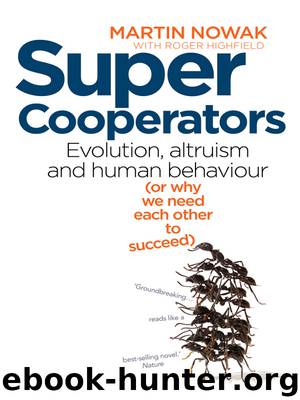SuperCooperators by Roger Highfield

Author:Roger Highfield
Language: eng
Format: epub
Tags: SCI000000, SCI008000, SCI027000
ISBN: 9781921799846
Publisher: The Text Publishing Company
Published: 2011-05-29T16:00:00+00:00
RISE OF THE SUPERORGANISM
A well-flavoured vegetable is cooked, and the individual is destroyed; but the horticulturist sows seeds of the same stock, and confidently expects to get nearly the same variety. . . . Thus I believe it has been with social insects: a slight modification of structure, or instinct, correlated with the sterile condition of certain members of the community, has been advantageous to the community: consequently the fertile males and females of the same community flourished, and transmitted to their fertile offspring a tendency to produce sterile members having the same modification.
—Charles Darwin, On the Origin of Species
Atta is not alone when it comes to being a master of cooperation. Think of a single worker bee. This solitary insect is as useless as a severed finger. But when attached to a colony, the bee becomes as useful as a digit on a hand. Now that bee can probe for the nectar of flowers and, once it has found a rich new source, point fellow hive members to these rich feeding grounds. Rather than gesture with wing or antenna, it uses a dance rich with symbolic information. In the same way that many factors and proteins coordinate the activity of cells in that organism known as the human body, so dozens of chemicals made by honeybee queens, workers, and brood play a role in social organization. Beehives are organized around an egg-laying queen tended by workers who, during their lifetime, make the transition from hivebound duties, such as nursing larvae, to more far-reaching jobs, such as foraging for food or defending the nest.
The different cell types in multicellular organisms are analogous to the different castes in a beehive, with workers constituting the soma— body tissue—and the queens representing the germ line, eggs and sperm. And, just as the body has mechanisms to weed out sickly cells, by apoptosis, a bee colony can regulate the lifespan of its members. The genome of our bodies is “optimized” by natural selection to build a good level of cooperation between germ line cells and soma cells with the help of apoptosis and various other processes. The same goes for breeding “good” workers and “good” queens. When I say good, I mean that they successfully reproduce and cooperate.
But, as we have seen in earlier chapters, there is a dark side to cooperation that comes in the form of parasites, cheats, defectors, and other lowlifes. In a healthy hive, workers identify and terminate cheats and abnormal colony members, ranging from embryos to adults. So long as this regulation continues, the colony thrives. However, if the types of worker that enforce order become too few, or if hive members change into malignant forms that can sidestep control mechanisms to replicate aberrantly, order is replaced by anarchy that ultimately leads to the decline and fall of the bee society.
There are some well-documented examples of the chaotic collapse of bee society. Take the relocation of the Cape honeybee by beekeepers from southern to northern South Africa in 1990. The result was the widespread death of managed African honeybees, Apis mellifera scutellata.
Download
This site does not store any files on its server. We only index and link to content provided by other sites. Please contact the content providers to delete copyright contents if any and email us, we'll remove relevant links or contents immediately.
| Biomathematics | Differential Equations |
| Game Theory | Graph Theory |
| Linear Programming | Probability & Statistics |
| Statistics | Stochastic Modeling |
| Vector Analysis |
Modelling of Convective Heat and Mass Transfer in Rotating Flows by Igor V. Shevchuk(6376)
Weapons of Math Destruction by Cathy O'Neil(6116)
Factfulness: Ten Reasons We're Wrong About the World – and Why Things Are Better Than You Think by Hans Rosling(4675)
Descartes' Error by Antonio Damasio(3209)
A Mind For Numbers: How to Excel at Math and Science (Even If You Flunked Algebra) by Barbara Oakley(3206)
Factfulness_Ten Reasons We're Wrong About the World_and Why Things Are Better Than You Think by Hans Rosling(3185)
TCP IP by Todd Lammle(3117)
Fooled by Randomness: The Hidden Role of Chance in Life and in the Markets by Nassim Nicholas Taleb(3025)
Applied Predictive Modeling by Max Kuhn & Kjell Johnson(3006)
The Tyranny of Metrics by Jerry Z. Muller(2983)
The Book of Numbers by Peter Bentley(2897)
The Great Unknown by Marcus du Sautoy(2631)
Once Upon an Algorithm by Martin Erwig(2585)
Easy Algebra Step-by-Step by Sandra Luna McCune(2560)
Lady Luck by Kristen Ashley(2513)
Practical Guide To Principal Component Methods in R (Multivariate Analysis Book 2) by Alboukadel Kassambara(2485)
Police Exams Prep 2018-2019 by Kaplan Test Prep(2467)
All Things Reconsidered by Bill Thompson III(2345)
Linear Time-Invariant Systems, Behaviors and Modules by Ulrich Oberst & Martin Scheicher & Ingrid Scheicher(2321)
